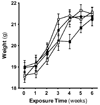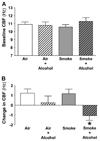Effects of cigarette smoke and alcohol on ciliated tracheal epithelium and inflammatory cell recruitment
- PMID: 17079783
- PMCID: PMC2215768
- DOI: 10.1165/rcmb.2005-0440OC
Effects of cigarette smoke and alcohol on ciliated tracheal epithelium and inflammatory cell recruitment
Abstract
Ciliated epithelium represents the first line of host defense against lung infection. Most alcoholics smoke and are at high risk for developing lung infections. We reported that cigarette smoke activates protein kinase C (PKC) and alcohol desensitizes ciliary beat frequency (CBF) to beta-agonists in bovine bronchial epithelial cells in vitro. The combined effect of smoke and alcohol exposure on mouse ciliated tracheal epithelium has not been studied in vivo. We hypothesized that previously observed in vitro effects of smoke and alcohol exposure could be replicated in vivo. Female C57BL/6 mice were exposed to whole body cigarette smoke only, 20% alcohol ad libitum in drinking water only, or the combination of cigarette smoke plus alcohol for 6 wk. Bronchoalveolar lavage (BAL) cell populations, CBF, and airway kinase activity were assessed. Total BAL cells were decreased in animals exposed to alcohol alone and increased in animals exposed to smoke alone. Mice receiving smoke and alcohol had cell levels similar to smoke alone. Baseline CBF was not affected in any group; however, isoproterenol stimulation of CBF was blunted by alcohol exposure and actually slowed below baseline in the smoke plus alcohol group. Isoproterenol-induced PKA activity was inhibited in mice receiving alcohol independent of smoke exposure. Smoke activated PKC independent of alcohol. The isoproterenol-induced slowing below baseline of CBF after combined smoke and alcohol exposure demonstrates a novel ciliary impairment likely related to the combination of alcohol-mediated PKA desensitization and smoke-stimulated PKC activation, possibly through acetaldehyde present in the vapor phase of cigarette smoke.
Conflict of interest statement
Figures





References
-
- Wanner A, Salathe M, O’Riordan TG. Mucociliary clearance in the airways. Am J Respir Crit Care Med. 1996;154:1868–1902. - PubMed
-
- Olseni L, Wollmer P. Mucociliary clearance in healthy men at rest and during exercise. Clin Physiol. 1990;10:381–387. - PubMed
-
- Deshpande VR, Jadhav JH. Specific blockade of spasmogens by beta-receptor stimulation with nylidrin and isoprenaline. J Pharm Pharmacol. 1970;22:101–103. - PubMed
-
- Wyatt TA, Spurzem JR, May K, Sisson JH. Regulation of ciliary beat frequency by both PKA and PKG in bovine airway epithelial cells. Am J Physiol. 1998;275:L827–L835. - PubMed
-
- Salathe M, Pratt MM, Wanner A. Protein kinase C-dependent phosphorylation of a ciliary membrane protein and inhibition of ciliary beating. J Cell Sci. 1993;106:1211–1220. - PubMed
Publication types
MeSH terms
Substances
Grants and funding
LinkOut - more resources
Full Text Sources

